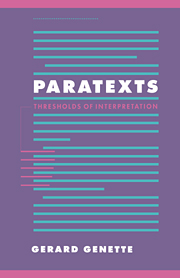Book contents
- Frontmatter
- Contents
- Foreword
- List of books by Gérard Genette
- Translator's note
- 1 Introduction
- 2 The publisher's peritext
- 3 The name of the author
- 4 Titles
- 5 The please-insert
- 6 Dedications and inscriptions
- 7 Epigraphs
- 8 The prefatorial situation of communication
- 9 The functions of the original preface
- 10 Other prefaces, other functions
- 11 Intertitles
- 12 Notes
- 13 The public epitext
- 14 The private epitext
- 15 Conclusion
- Additional references
- Index
Foreword
Published online by Cambridge University Press: 04 November 2009
- Frontmatter
- Contents
- Foreword
- List of books by Gérard Genette
- Translator's note
- 1 Introduction
- 2 The publisher's peritext
- 3 The name of the author
- 4 Titles
- 5 The please-insert
- 6 Dedications and inscriptions
- 7 Epigraphs
- 8 The prefatorial situation of communication
- 9 The functions of the original preface
- 10 Other prefaces, other functions
- 11 Intertitles
- 12 Notes
- 13 The public epitext
- 14 The private epitext
- 15 Conclusion
- Additional references
- Index
Summary
Pausing on the threshold
Read, read, read, read, my unlearned reader! read, – or by the knowledge of the great saint Paraleipomenon – I tell you before-hand, you had better throw down the book at once; for without much reading, by which your reverence knows, I mean much knowledge, you will no more be able to penetrate the moral of the next marbled page (motley emblem of my work!) than the world with all its sagacity has been able to unravel the many opinions, transactions and truths which still lie mystically hid under the dark veil of the black one.
Sterne, Tristram Shandy, III, 36Laurence Sterne, that pioneer anatomist of the physical body of the book, is offering advice to one of the much put-upon fictive readers of his antic text. What follows is indeed a literal “marbled page,” which by the convention of eighteenth-century binders marks the outermost limits of the text and by the nature of its production is both unique and stylized. Sterne had already presented his reader with his celebrated “black page” marking the innermost and overdetermined limits of the text itself. The marbled page is part of the frame containing both the text itself and all the liminal devices – titles, signs of authorship, dedications, epigraphs, prefaces, notes, intertitles, epilogues, and the like – that mediate the relations between text and reader. As the Russian formalist critic Viktor Shklovsky long ago pointed out, Tristram Shandy “lays bare” the constructional principles of the novel as genre by a series of devices (priemy) that fundamentally disturb the narrative conventions of the book.
- Type
- Chapter
- Information
- ParatextsThresholds of Interpretation, pp. xi - xxiiPublisher: Cambridge University PressPrint publication year: 1997
- 7
- Cited by



